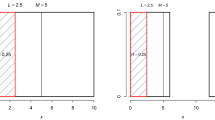Summary
The Bonferroni index (B) is a measure of income and wealth inequality, and it is particularly suitable for poverty studies. Since most income surveys are of a sample nature, we propose Bayes estimators ofB from a Pareto/I population. The Bayesian estimators are obtained assuming a squared error loss function and, as prior distributions, the truncated Erlang density and the translated exponential one. Two different procedures are developed for a censored sample and for income data grouped in classes.
Similar content being viewed by others
References
Aaberge R (2000) Characterizations of Lorenz curves and income distributions, Social Choice and Welfare17(4): 639–653
Arnold, BC, Press SJ (1983) Bayesian inference for Pareto populations, Journal of Econometrics21: 287–306
Arnold BC, Press SJ (1986) Bayesian analysis of censored or grouped data from Pareto populations. In: Bayesian Inference and Decision Techniques, Essays in Honor of Bruno de Finetti. (Goel PK, Zellner A, eds.) North-Holland, Amsterdam 157–173
Bernardo JM, Smith AFM (1994) Bayesian Theory, Wiley, Chichester
Bhattacharya SK, Chathurvedi A, Sing NK (1999) Bayesian estimation for the Pareto Income distribution. Statistical Papers40(3): 247–262
Bonferroni CE (1930) Elementi di Statistica Generale. Seeber. Firenze
Ganguly A, Sing NK, Chouderi H, Bhattacharya SK (1992). Bayesian Estimation of the Gini Index for the PID, Test1(1): 93–104
Giorgi GM (1998) Concentration Index, Bonferroni, Encyclopedia of Statistical Sciences, Update, 2, Wiley, NY 141–146
Giorgi GM, Crescenzi M (2001) A proposal of poverty measures based on the Bonferroni inequality index, Metron,59 (3–4): 3–16
Giorgi GM, Mondani R (1994) The exact sampling distribution of the Bonferroni concentration index, Metron,52 (3–4): 5–41
Giorgi GM, Mondani R (1995) Sampling distribution of the Bonferroni inequality index from Exponential population, Sankhya, Series B57 (1): 10–18
Mehran F (1976) Linear measures of income inequality, Econometrica44 (4): 805–809
Moothathu TSK (1985) Sampling distributions of the Lorenz Curve and Gini Index of the Pareto Distribution, Sankhya, Series B,47 (2): 247–258
Moothathu TSK (1990) The best estimator and a strongly consistent asymptotically normal unbiased estimator of Lorenz curve, Gini index and Theil entropy index of Pareto distribution. Sankhya, Series B52 (1): 115–127
Nygård F, Sandström A (1981), Measuring Income Inequality. Stockolm: Almqvist & Wiksell International
Takayama N (1979) Poverty, income inequality, and their measures: Professor Sen's axiomatic approach reconsidered, Econometrica47 (3): 747–759
Author information
Authors and Affiliations
Rights and permissions
About this article
Cite this article
Giorgi, G.M., Crescenzi, M. Bayesian estimation of the Bonferroni index from a Pareto-type I population. Statistical Methods & Applications 10, 41–48 (2001). https://doi.org/10.1007/BF02511638
Issue Date:
DOI: https://doi.org/10.1007/BF02511638



